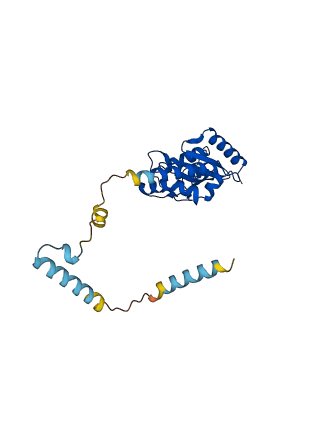P33296
Gene name |
UBC6 (DOA2, YER100W) |
Protein name |
Ubiquitin-conjugating enzyme E2 6 |
Names |
E2 ubiquitin-conjugating enzyme 6, Ubiquitin carrier protein UBC6, Ubiquitin-protein ligase UBC6 |
Species |
Saccharomyces cerevisiae (strain ATCC 204508 / S288c) (Baker's yeast) |
KEGG Pathway |
sce:YER100W |
EC number |
2.3.2.23: Aminoacyltransferases |
Protein Class |
|

Descriptions
The autoinhibited protein was predicted that may have potential autoinhibitory elements via cis-regPred.
Autoinhibitory domains (AIDs)
Target domain |
|
Relief mechanism |
|
Assay |
cis-regPred |
Accessory elements
No accessory elements
Autoinhibited structure

Activated structure

1 structures for P33296
| Entry ID | Method | Resolution | Chain | Position | Source |
|---|---|---|---|---|---|
| AF-P33296-F1 | Predicted | AlphaFoldDB |
3 variants for P33296
| Variant ID(s) | Position | Change | Description | Diseaes Association | Provenance |
|---|---|---|---|---|---|
| s05-359947 | 130 | H>Q | No | SGRP | |
| s05-360101 | 182 | T>A | No | SGRP | |
| s05-360243 | 229 | D>G | No | SGRP |
No associated diseases with P33296
1 regional properties for P33296
| Type | Name | Position | InterPro Accession |
|---|---|---|---|
| domain | Ubiquitin-conjugating enzyme E2 | 5 - 167 | IPR000608 |
Functions
| Description | ||
|---|---|---|
| EC Number | 2.3.2.23 | Aminoacyltransferases |
| Subcellular Localization |
|
|
| PANTHER Family | ||
| PANTHER Subfamily | ||
| PANTHER Protein Class | ||
| PANTHER Pathway Category | No pathway information available | |
4 GO annotations of cellular component
| Name | Definition |
|---|---|
| endoplasmic reticulum | The irregular network of unit membranes, visible only by electron microscopy, that occurs in the cytoplasm of many eukaryotic cells. The membranes form a complex meshwork of tubular channels, which are often expanded into slitlike cavities called cisternae. The ER takes two forms, rough (or granular), with ribosomes adhering to the outer surface, and smooth (with no ribosomes attached). |
| endoplasmic reticulum membrane | The lipid bilayer surrounding the endoplasmic reticulum. |
| integral component of membrane | The component of a membrane consisting of the gene products and protein complexes having at least some part of their peptide sequence embedded in the hydrophobic region of the membrane. |
| nucleus | A membrane-bounded organelle of eukaryotic cells in which chromosomes are housed and replicated. In most cells, the nucleus contains all of the cell's chromosomes except the organellar chromosomes, and is the site of RNA synthesis and processing. In some species, or in specialized cell types, RNA metabolism or DNA replication may be absent. |
3 GO annotations of molecular function
| Name | Definition |
|---|---|
| ATP binding | Binding to ATP, adenosine 5'-triphosphate, a universally important coenzyme and enzyme regulator. |
| ubiquitin conjugating enzyme activity | Isoenergetic transfer of ubiquitin from one protein to another via the reaction X-ubiquitin + Y -> Y-ubiquitin + X, where both the X-ubiquitin and Y-ubiquitin linkages are thioester bonds between the C-terminal glycine of ubiquitin and a sulfhydryl side group of a cysteine residue. |
| ubiquitin-protein transferase activity | Catalysis of the transfer of ubiquitin from one protein to another via the reaction X-Ub + Y --> Y-Ub + X, where both X-Ub and Y-Ub are covalent linkages. |
3 GO annotations of biological process
| Name | Definition |
|---|---|
| protein monoubiquitination | Addition of a single ubiquitin group to a protein. |
| protein polyubiquitination | Addition of multiple ubiquitin groups to a protein, forming a ubiquitin chain. |
| ubiquitin-dependent ERAD pathway | The series of steps necessary to target endoplasmic reticulum (ER)-resident proteins for degradation by the cytoplasmic proteasome. Begins with recognition of the ER-resident protein, includes retrotranslocation (dislocation) of the protein from the ER to the cytosol, protein ubiquitination necessary for correct substrate transfer, transport of the protein to the proteasome, and ends with degradation of the protein by the cytoplasmic proteasome. |
2 homologous proteins in AiPD
| 10 | 20 | 30 | 40 | 50 | 60 |
| MATKQAHKRL | TKEYKLMVEN | PPPYILARPN | EDNILEWHYI | ITGPADTPYK | GGQYHGTLTF |
| 70 | 80 | 90 | 100 | 110 | 120 |
| PSDYPYKPPA | IRMITPNGRF | KPNTRLCLSM | SDYHPDTWNP | GWSVSTILNG | LLSFMTSDEA |
| 130 | 140 | 150 | 160 | 170 | 180 |
| TTGSITTSDH | QKKTLARNSI | SYNTFQNVRF | KLIFPEVVQE | NVETLEKRKL | DEGDAANTGD |
| 190 | 200 | 210 | 220 | 230 | 240 |
| ETEDPFTKAA | KEKVISLEEI | LDPEDRIRAE | QALRQSENNS | KKDGKEPNDS | SSMVYIGIAI |
| FLFLVGLFMK |